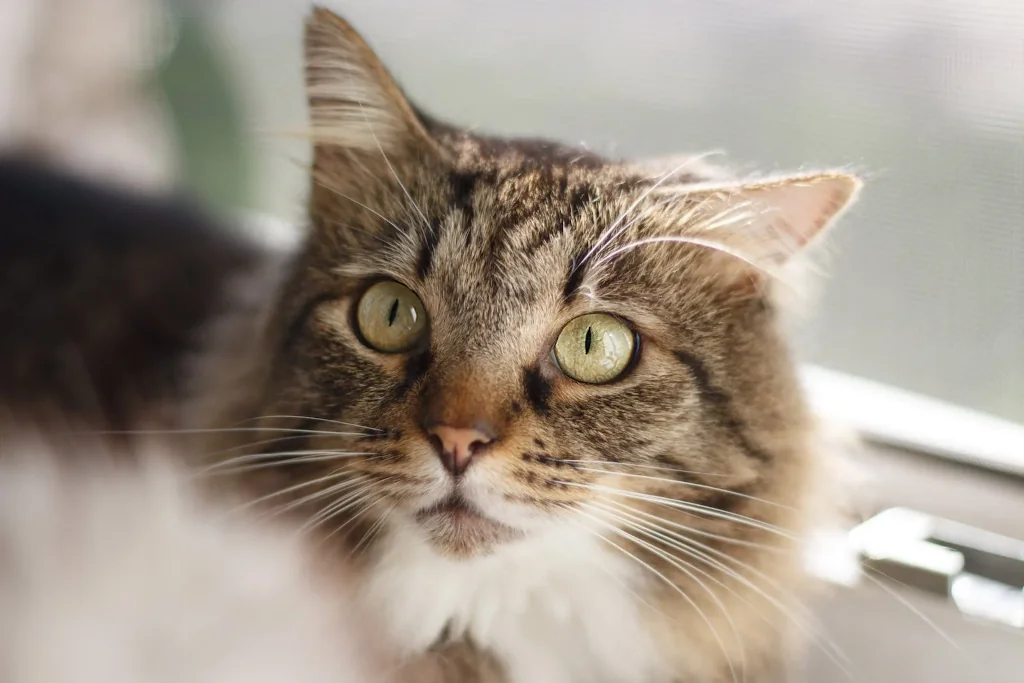Disclosure: We may earn a commission from helpful, relevant links in our content. No cost to you. See our privacy policy.
Cats, those enigmatic creatures, can leave us scratching our heads when they suddenly stop meowing or, conversely, can’t seem to stop at all.
The world of cat vocalization is vast, but today, we’re zoning in on one specific aspect—how to encourage your cat to meow.
It’s frustrating when your once chatty cat falls silent or your quiet kitten doesn’t find her voice. Perhaps you’ve spent hours searching the internet, scanning articles, and watching videos, all to no avail. Well, the search ends here.
With our deep understanding of cat behavior and training, we’ll guide you step-by-step in teaching your cat to meow. Together, let’s give your cat a voice and build a richer bond through this vocal expression.

Why Do Cats Meow?
Cats meow as their primary way to communicate with humans. Each meow can differ in tone, volume, and frequency, hinting at their specific needs or moods.
Feeling peckish? Expect a long-drawn meow around meal times. A sudden loud meow might indicate distress or a plea for your immediate attention.
Remember, a contented cat is typically a quiet one, so an unusually vocal kitty might be their way of telling you something’s up. Like a barista crafting the perfect espresso, understanding your cat’s meow is both an art and a science – and it starts with listening closely.
Is Your Cat Silent? Reasons Behind Quietness
But what about the silent cats, you ask? While some felines could give opera singers a run for their money, others prefer to remain silent.
A quiet cat isn’t necessarily a cause for concern – just like humans, every cat has a unique personality. Some are chatterboxes, others, less so.
But a sudden change in your cat’s usual behavior, including its voice, could hint at a possible health issue. If your normally vocal cat has turned mute, it’s worth checking in with your vet to rule out any potential medical problems.
Remember, when it comes to cats, it’s always better to be safe than sorry. Now, let’s see how you can encourage your feline friend to express themselves more vocally.
Pro Tip:
Cats’ vocalizations can change with age. Don’t be surprised if your previously talkative kitten turns into a more reserved adult cat or vice versa. It’s all part of their personal development!
Teaching Your Cat to Meow: A Step-by-step Guide
Understanding Your Cat’s Personality
Before embarking on this feline vocal journey, it’s essential to know that each cat has a unique personality and communication style. Some cats are naturally more vocal than others.
Breeds like the Siamese are known for their loquacious nature, while others like the Russian Blue are typically more reserved. So, don’t worry if your cat isn’t the Pavarotti of the pet world. The key here is to understand your cat’s personality and to respect it.
Establish a Reward System
Cats are clever creatures, and they’re more likely to repeat a behavior if it results in a positive outcome. To encourage your cat to meow, establish a reward system.
This could be a favorite treat, a gentle petting session, or a quick playtime with a beloved toy. The idea is to associate meowing with a positive experience so that your cat is more likely to repeat it.
Teach with Consistency
Consistency is key in any training regimen. Start by choosing a specific time each day for the training sessions. During these sessions, try calling your cat’s name or use a specific word or sound that you’d like your cat to associate with meowing.
Once they meow, promptly reward them with their favorite treat or affection. Be patient and persistent, as it might take some time for your cat to understand what you want.
Keep it Short and Sweet
Cats have fairly short attention spans when it comes to training. It’s crucial to keep the sessions short, ideally no longer than 5-10 minutes. Multiple short sessions a day are better than one long one.
Remember, the aim is to keep the training experience positive for your cat, as this is how positive reinforcement works.
Respect Their Mood and Comfort
Just as humans don’t feel like talking all the time, your cat might also have its quiet moments. Respect your cat’s mood and comfort level.
If they seem disinterested or agitated during a training session, it’s better to stop and try again later. Never force your cat to meow.
Pro Tip:
When you’re training your cat, keep an eye out for signs of stress or discomfort. If your cat is avoiding you, hiding, or displaying aggressive behavior, it’s time to give them some space and try again later.
Remember, every cat is unique, so it might take some trial and error to understand what works best for your feline friend. With patience, consistency, and respect for their comfort and mood, you can encourage your kitty to find their voice. Happy training!
Suggested read: How to Train a Cat To “Leave it”

When and Why To Encourage Your Cat to Meow
As we’ve previously said, a cat’s meow is more than just a sound; it’s a method of communication.
Encouraging your cat to meow can be a way to enhance your bond and increase their trust in you. Not only does it provide you with a deeper understanding of their needs, but it also gives them a means of expressing themselves.
The best times to encourage your cat to meow are during their active hours, usually in the morning or late evening. If you’re trying to train your cat to meow, use positive reinforcement techniques such as treats or playtime during these periods.
However, remember not to encourage meowing for negative behavior like begging for food, as this can lead to habits you may not appreciate in the long run.
Suggested reading: Cat Training – Train Your Cat To “Stay”
Is it Okay to Respond to Your Cat’s Meows?
Responding to your cat’s meow can strengthen your relationship, as it communicates to them that you understand and respect their needs.
Let me share a story about Smokey, my male cat. He has a very specific meow when he wants attention. Initially, I wasn’t sure how to respond, but over time, I realized he wanted to play when he made that specific sound.
Now, when Smokey gives his “playtime meow,” I make sure to play with him for a bit, whether it’s a chase with his favorite feather toy or a bit of a wrestle with a soft catnip mouse. Responding to his meow in this way has not only created a deeper bond between us, but it also helped me understand his needs and wants better.
Improve your cat behavior by teaching your cat:
FAQs
Do all cat breeds meow the same way?
Different cat breeds have varying vocalization patterns. For instance, Siamese cats are known for their loud, distinct meows, while Maine Coons often communicate through soft trills and chirps.
Can lots of meowing be a sign of a health issue?
Excessive meowing can indeed signal a health issue, particularly in older cats. It may indicate conditions like hyperthyroidism, high blood pressure, or even cognitive dysfunction syndrome. If your cat’s meowing patterns change abruptly, it’s wise to consult a vet.
My cat meows too much, how can I reduce it?
To reduce excessive meowing, identify the cause first. If it’s due to attention-seeking behavior, redirect it positively by establishing playtimes. If it’s hunger-driven, consider an automatic feeder to provide small meals throughout the day. In case of anxiety or health issues, consult your vet.
Is meowing the only way cats communicate?
No, cats have a rich communication repertoire that extends beyond meowing. They also purr, hiss, trill, and use body language, like tail position and ear movement, to express themselves. Understanding these cues can help you better communicate with your feline friend.
Alex, a passionate animal lover, has experience in training and understanding animal behavior. As a proud pet parent to two dogs and three cats, he founded AnimalReport.net to share insights from animal experts and expand his knowledge of the animal kingdom.




